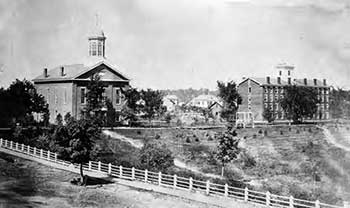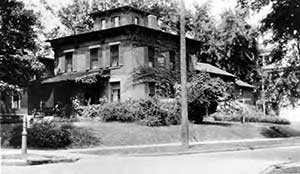Oberlin, Ohio Project
A Brief Narrative Introduction with Pictorial Highlights
Civil War abolitionism, playing home to the to the Cleveland Air Route Traffic Control Center, founding the Ohio Anti-Saloon League during the Temperance Movement, National Historic Landmarks, and a roving troupe of albino squirrels in Tappan Square demonstrate the wealth of diversity in attractions that make the historic City of Oberlin unique and surprising.
Rhapsodized and memorialized as the The Town That Started the Civil War1 in Nat Brandt's scholarly book, the City of Oberlin has been steeped in progressive thought since it was founded in 1833 by Presbyterian ministers John Jay Shipherd and Philo P. Stewart.
A massive old elm tree once shaded the southeast corner of the land that became picturesque Tappan Square. The tree was next to the first home in Oberlin, a log cabin homestead that belonged to the Pease family. The elm also was rumored to be the site where city founders Shipherd and Stewart prayed for guidance on where to found their new utopian town. The First Church in Oberlin was organized soon afterwards, in 1834.
Namesake of the Alsatian minister Jean-Frédéric Oberlin, the City served as a "station" on the Underground Railroad to many fugitives, notably John Price. The Oberlin-Wellington Rescue of Price in 1858 by famous fiery abolitionists, including John Mercer Langston and Charles Henry Langston, led to national attention and fueled the raid on Harper's Ferry in 1859 that sparked the Civil War, an event which notably included Oberlin abolitionists.
In addition to abolitionism, the city also notoriously supported prohibition, founding the Anti-Saloon League of America in the Spear Library of Oberlin College in 1893.
Among the many beautiful architectural features located on the Oberlin College campus are Peters Hall , the former Carnegie Library, Wilder Hall, Bosworth Hall and Fairchild Chapel, Baldwin Cottage, Cox Administration Building, Severance Chemical Laboratory, Hall Auditorium, Talcott Hall, Finney Chapel, the Memorial Arch, Allen Memorial Art Museum, the Katharine Wright Haskell Memorial Fountain, Johnson House, and the Oberlin Inn. Browse all images of Oberlin College.
In addition to Oberlin College, further National Historical Landmarks located in the City of Oberlin are the homes of famed abolitionists, Wilson Bruce Evans and John Mercer Langston. Frank Lloyd Wright's Weltzheimer-Johnson House, the Monroe House, Jewett House, the Little Red Schoolhouse, the Charles Martin Hall House (National Historic Chemical Landmark), First Church, Tappan Square, and Westwood Cemetery are among the many important treasures located in the City of Oberlin that make visiting a delight.
See photos of some of these "treasures."
1 Brandt, Nat. The town that started the Civil War, Syracuse University Press: Syracuse, NY 1990.






